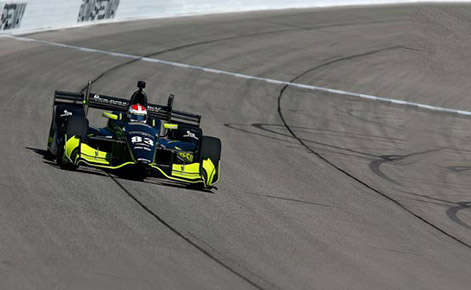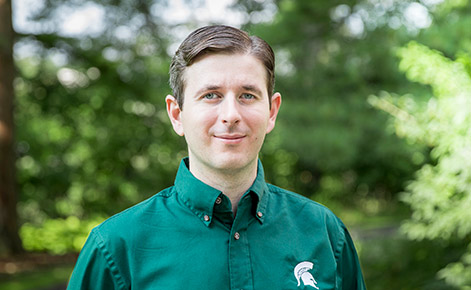Two new publications from Michigan State University’s David Ferguson highlight the world of motorsports—and give critical competitive-edge insights for athletes, especially those with diabetes.
“With racing, driver heart rates are at 170 beats per minute for 2 to 4 hours. They burn 2,000 calories. Their core temperature can increase to 103 degrees Fahrenheit depending on the ambient environment. They are undergoing immense physical stress at 200 miles per hour,” said Ferguson, an assistant professor in the Department of Kinesiology. The physicality can influence diabetic racers, who have to keep in mind their own bodily needs on top of the intense sport.

IndyCar Series driver Charlie Kimball. Photo courtesy of LAT Photo USA.
The four-second difference
IndyCar driver Charlie Kimball, a long-time partner in research with Ferguson, is featured in both publications.
When Kimball, a Type 1 diabetic, first started racing in the “elite level” in 2010, he was one of the very few racers to be a diabetic. Ferguson has spent the last six years working with Kimball to determine Kimball’s physical fitness, how it changed over time and how diabetes had an impact, if any, on his racing performance. The research was highlighted in the 2016-17 New Educator—and a September publication in the Journal of Strength and Conditioning with fellow MSU scholar Nicholas Myers is the “conclusion” of the story.
“The research is specific to all diabetic racers, though it is a case study on Charlie,” said Ferguson.
Since Kimball began racing, the number of male Type 1 diabetic drivers has escalated to more than one hundred in eight years across all levels of racing. To date, there are no female diabetic racers that Ferguson was able to identify.
“Drivers are seeing, if Charlie can do it, so can I. We’ve been researching how blood glucose influences performance, but individuals don’t always have the finances, physicians or research backing them like Charlie. Racers need this information.”
Ferguson and Myers found through the years of data and testing that the typical driver has a “sweet spot” of blood glucose in which they are four seconds faster than when they are outside that range: 140-168 milligrams/deciliter. The researchers found this over and over in test results, and regardless of track type.
“In the context of racing, this glucose window is ideal for performance. With that being said, someone who has a normally functioning pancreas (non-diabetic) will already be in that range. To get on a level playing field, this is the info drivers with diabetes need,” said Ferguson.
Racing: More than just turning left
Kimball also contributed a chapter to a book Ferguson edited: “The Science of Motorsport” (Routledge, 2019).
 Comprised of practitioner experience and academic research, including a chapter on psychology from Karl Erickson and Dan Gould of MSU, the textbook covers all facets of racing, including IndyCar, NASCAR, Formula 1 and others. It is an important addition to an understudied area, and provides an accessible and up-to-date resource for stakeholders at all levels of motorsport.
Comprised of practitioner experience and academic research, including a chapter on psychology from Karl Erickson and Dan Gould of MSU, the textbook covers all facets of racing, including IndyCar, NASCAR, Formula 1 and others. It is an important addition to an understudied area, and provides an accessible and up-to-date resource for stakeholders at all levels of motorsport.
“The book addresses physiology, sports medicine, nutrition, psychology, physical training, safety, managing a concussion and information for pit crews and officials on and off the track,” Ferguson said.
Ferguson collaborated with leaders in the industry—such as Jeff Horton and Dr. Terry Trammel, the head engineer and physician from IndyCar—to contribute chapters. Ferguson wrote the introduction with 2017 Kinesiology graduate Lydia Pineault, and a chapter on driver and team interactions.
“This book shares all the data we know, and how it can be beneficial to drivers,” Ferguson continued. “We haven’t unlocked all the physiology of racers just yet, but this is a big step in getting there.”





